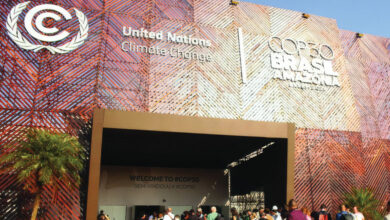A world of difference


Bord Bia CEO, Tara McCarthy, speaks to Owen McQuade about a year of impressive export performance for Ireland’s food and drink sector in 2017, Bord Bia’s role in developing international markets and driving innovation to support the sector.
Tara McCarthy has had a particularly busy morning presenting the details of Bord Bia’s annual report on ‘Export Performance and Prospects’. The report, launched by Minister Michael Creed, TD, highlights another record year for Irish food and drink exports. The industry recorded a 13 per cent rise, its eighth consecutive year of growth and almost 60 per cent or €4.7 billion ahead of the 2010 figure.
McCarthy outlines the “huge performance” from the industry given the often-challenging backdrop in which it was achieved.
“The powerhouses for overall growth in exports are the dairy and meat sectors, along with beverages. Dairy contributed to 45 per cent of the growth in the industry’s global exports last year and meat 8 per cent. The beverage industry has also transformed itself over the last number of years. In 2014, we had four distilleries and we have 18 today. It is now a multi-dimensional industry with every part of it going through significant expansion and deepening market reach leading to impressive growth.”
“The powerhouses for overall growth in exports are the dairy and meat sectors, along with beverages.”
Turning to the challenges of 2017 McCarthy added that: “While the global economy grew and commodity prices were reasonably positive, Ireland’s biggest market for food and drink exports, the UK, was unsettled by the impending Brexit, currency challenges in particular remained a strain. This also paused significant decision-making by customers in that market and has added a real pressure point for managing market growth. However, the industry has risen to that challenge and actually increased its exports to the UK by 7 per cent in 2017.”
McCarthy outlines the importance of Bord Bia`s growth strategy, ‘Making a World of Difference’ in supporting the industry to meet the growth ambitions in Food Harvest 2020 and FoodWise 2025 in what is and will be a challenging trading environment.
“The five pillars of our strategy, each of which supports growth, concentrate on:
• decision making informed by insight;
• enabled by valued people, talent and infrastructure;
• Origin Green underpinning sustainable production;
• the realisation of effective routes to market; and
• strong brand communications to carry the message to key global audiences in the digital age.”
Insight
McCarthy maintains that market, client and consumer insight is critical to the delivery of this growth.
“We have been investing in insight for many years and in our ‘Thinking House’, we now have a resource available to industry to demonstrate how placing the consumer at the heart of the food industry can unlock new opportunities.
“We have a unique, robust and independently accredited sustainability infrastructure but it needs to move on further.”
“The additional budgetary resources we received from the Department of Agriculture, Food and the Marine in 2017 to meet the Brexit challenge has allowed us to accelerate our investment in terms of research and the growth supporting initiatives we are building out of this are assisting companies in the UK market as well as facilitating growth and diversification in the EU26 and international markets.”
One example of this insight is a data driven analysis of its 180 export markets to identify those that will deliver the best realistic potential for growth.
“Market prioritisation is our most comprehensive and robust examination of markets from a route to market perspective ever undertaken. Using focused criteria we looked across our markets by sector for growth opportunities and carefully filtered out the top 15. Working with industry we are now identifying the top five market opportunities, or “white spaces”, in each of the sectors which Irish companies will target for growth. For example, in meat and dairy, we are looking east towards a broader set of international markets.
“If Ireland, or Europe, doesn’t have access to a particular market on our list we will be working with the Department of Agriculture, Food and the Marine and the Department of Foreign Affairs and Trade to justify pursuing market access. The insight will also inform where we deploy resources for trade fairs, trade events and market visits and play a key role in identifying destinations for trade missions headed by our Minister.
“We will draw on this research as we work with client companies on how they write new business and the key supports required by them to succeed.”
Talent
McCarthy places a premium on the role of talent in the industry’s growth: “Investing in human talent is becoming more important than ever so that the skill sets in the industry evolve to meet new consumer and market demands. The launch for example of our new MSc partnership with NUI Maynooth in Design Innovation in the food sector is bringing consumer insight to the heart of market-led decision-making because innovation is not just about NPD [new product development], it is also about understanding how products can shape consumers’ lives for the commercial benefit of trade customers.”
Origin Green
Now celebrating its fifth birthday, Origin Green has seen Ireland put in place a unique, world-first sustainability infrastructure. The programme now has over 50,000 farmers signed up, almost 100 per cent of the dairy industry and processors that account for 90 per cent of exports. The evolution of the programme has seen it more recently move into the retail and foodservice sectors, fastening the final link of the supply chain to consumers.
McCarthy says: “We have a unique, robust and independently accredited sustainability infrastructure but it needs to move on further. We are refreshing our insight to determine what the consumer of tomorrow wants from a sustainable food and beverage perspective so that we can ensure a future-proofed Origin Green.”
The programme reflects a theme running through Bord Bia’s work: collaboration. “All of our work has to have an Ireland Inc. approach. The culture and the ethos of Bord Bia is working in partnership with our stakeholders in government and industry,” she adds.
Brexit
On an impending Brexit McCarthy says that everything they do is viewed through a Brexit lens.
“Working with our board and senior management team we took a long, hard look at our strategy and the organisation over the past year to make sure we continue to deliver robust support in the changing trading environment particularly in the UK, our biggest market. We agreed to accelerate our activities around three of our strategic pillars namely Insight, Routes to Market and Origin Green.
“Our Brexit Barometer of 139 exporting companies in March of last year affirmed this approach which drove us on to build a toolkit of supports for companies which we are continuing to develop and roll out. Arguably the development of market-focused strategies and market prioritisation is work we would be doing regardless of Brexit, circumstances now demand that we do more and faster to protect and advance the interests of the food and drink industry.”
One year on
McCarthy reflects on her first year in the role as both exciting and challenging. “From a personal perspective, I have devoted considerable time to deepening my understanding of the industry. I have seen first-hand the strength of the industry and its players and how it has risen to every single challenge it has faced.”
“I have seen first-hand the strength of the industry and its players and how it has risen to every single challenge it has faced.”
This hands-on experience has offered McCarthy a renewed appreciation of the political and economic importance of the food industry and has also deepened her understanding of the commercial aspects which she was already familiar with from previous roles. “Since arriving here I have participated on trade missions, where policy and commerce come together to create meaningful results. It has been exciting and also hard work, as we have sought to restructure our own organisation and programmes. As the food industry enters a new chapter, we need to be fit for purpose ourselves and that has meant a lot of change. We have also had additional resources from the Department of Agriculture, Food and the Marine and we are looking forward as a team to the challenges of 2018.”
Future
McCarthy has a positive outlook for 2018, recognising that further challenges lie ahead. “We are facing some headwinds in the global economy. There will be pressure on some commodities that are currently at a high point with a risk of oversupply. These will create tensions in the industry but that makes it more important that we understand our markets through insights and the overriding need for sustainable supply chains.
“Key for us next year is to remain focused. One of the themes we worked on last year was around being data-driven and we are looking to introduce more data-driven decision-making into the industry this year,” she explains.
One major priority for Bord Bia in 2018 will be the development of a new strategy. McCarthy concludes: “We are coming to the final year of our current strategy and we have the ambition that by the summer of this year we will have completed the development of the new strategy. We expect that it will evolve from the current one but we need to make sure it is sharp and as relevant as possible to the needs of markets, particularly given the changing environment ahead.”
Profile: Tara McCarthy
Tara McCarthy was born in Clonakilty, West Cork. She graduated from NUI Galway with a BComm and with a Masters in Marketing from the Smurfit Business School, University College Dublin. Tara started her career with CBF, the Irish Livestock and Meat Board, on one of the student programmes still operated by Bord Bia. She spent three months at a meat plant, three months learning German and six months in Düsseldorf. She then worked in Düsseldorf for five years before moving to Paris for another five years, where she managed Bord Bia’s office. On her return to Dublin, Tara spent 10 years as head of Consumer Foods in Bord Bia, a role that evolved into managing the Food and Beverage Division. After a spell as CEO of BIM [Bord Iascaigh Mhara], Tara returned to Bord Bia as CEO in January 2017.
from the Smurfit Business School, University College Dublin. Tara started her career with CBF, the Irish Livestock and Meat Board, on one of the student programmes still operated by Bord Bia. She spent three months at a meat plant, three months learning German and six months in Düsseldorf. She then worked in Düsseldorf for five years before moving to Paris for another five years, where she managed Bord Bia’s office. On her return to Dublin, Tara spent 10 years as head of Consumer Foods in Bord Bia, a role that evolved into managing the Food and Beverage Division. After a spell as CEO of BIM [Bord Iascaigh Mhara], Tara returned to Bord Bia as CEO in January 2017.







